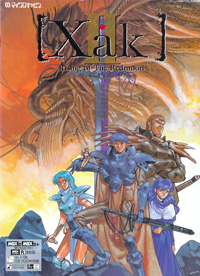Xak II: Rising of the Redmoon is a 1990 role-playing video game by Microcabin. It is a direct sequel to Xak: The Art of Visual Stage. The game was released in Japan only, but due to a MSX scene that arose in Europe (predominately in the Netherlands region) some of the MSX versions of Xak received fan translations. An enhanced remake was later released for the PC Engine, together with the first game in the series Xak as Xak I & II by Telenet Japan's development team Riot.
| Xak II: Rising of the Redmoon | |
|---|---|
 | |
| Developer(s) | Microcabin |
| Publisher(s) | Microcabin |
| Composer(s) | Ryuji Sasai Tadahiro Nitta |
| Platform(s) | FM Towns, MSX2, PC-88, PC-98, X68000, PC Engine (as Xak I & II) |
| Release | 1990 |
| Genre(s) | Action role-playing game |
| Mode(s) | Single-player |
Setting
editXak II, being a direct sequel to the first game in the series, it features the same high fantasy setting as Xak. The gods' division of the world into Xak, the world of men, Oceanity, the world faeries, and Xexis, the world of demons, as referenced in Xak, is depicted in this game's introduction. In this adventure, the main hero of the Xak series, Latok Kart is exploring a vast region situated around a single central village of Banuwa.
Story
editIn Xak, the protagonist Latok Kart fought and defeated the demon Zemu Badu. One of Badu's minions escaped, a black-robed man known only as Necromancer. Three years later, Necromancer is able to contact one of his allies from the demon world of Xexis: a fearsome demon called Zamu Gospel. Following a prophecy foretold by an ancient and extremely powerful sorcerer by the name of Amadok, the Necromancer and three other demons (referred to as Demonlords) are attempting to complete a dark ritual which will revive Zamu Gospel into the world of Xak.
The player once again controls Latok, now nineteen years of age. A rumour about the whereabouts of Latok's father Dork has surfaced around the village of Banuwa. Latok and his faerie companion Pixie travel to the village to investigate, but soon run into Gospel's minions.
Gameplay
editXak II follows the same structure as its predecessor. The game proceeds by the player finding their way through labyrinthine maps, defeating opposing monsters on the way. In each map, puzzles have to be solved and keys, NPCs and other objects have to be found to gain entrance to the room where a boss dwells. After defeating the boss, the player can proceed towards the next map, where the structure repeats. Various sub-quests involving NPCs are present, most of them obligatory.
Combat is in real-time. The player's character walks around on the game maps, as well as the monster characters. Each character has an attack and defense rating. The player can have Latok swing his sword by pressing an action key and if a monster character is near enough, it will sustain damage. Monsters damage Latok by touching him or hitting him with projectiles. This combat system requires some manual dexterity, especially during boss fights—bosses are generally several times larger than Latok himself.
Presentation
editOn MSX2, Xak II is displayed in a screen with a 256x212 display resolution. The game uses a scrolling display, the map scrolls away as the player's character reaches a distance from the screen's side of about 1/3 of the total display. Due to the larger amount of memory available to the 256x212 display compared to the 512x212 one, the game's scrolling is markedly smoother than in the first game.
The game's music supports both the internal PSG sound system, as well as the optional MSX-Music. In a style that is heard in most of Microcabin's productions for MSX, the PSG channels are used for the main melody and sound effects, while the MSX-Music channels are used for supporting instruments. This prominence of the PSG is less marked than in the first game.
External links
edit- XyZ: A tribute to the Xak, Ys and Zelda series Archived 2007-04-28 at the Wayback Machine
- Flame Bird